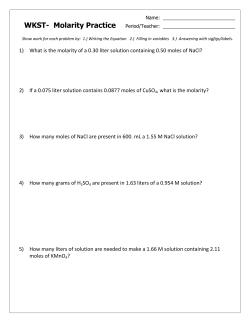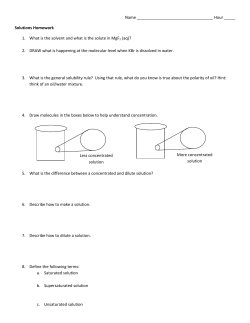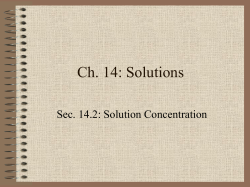
Molarity of ice tea lab
Name ______________________________ The Molarity of Iced Tea PRELAB: To be able to learn about solutions and their concentrations, first w e must review about solutions… Consider a solution with NaCl dissolved in w ater. 1. Which substance is the solute? ____________________ The solvent? _______________________ 2. What is the gram-‐formula mass o f NaCl? 3. If you had 117 g of NaCl, how many moles would you have? -‐-‐Remember to convert g to mol you multiply by (1 mole/gfm) During this lab you will be looking at the concentration of Tea. So if we had the same solution, but different volume, what happens to the molarity (or concentration)? Particle view of concentration: Draw the particles as they would Appear in each solution. Materials: Iced tea mix, large plastic cup, small plastic cups. Plastic spoons, balance, marker Procedure: 1. Complete the number of grams of iced tea you would need to make the following molarities. SHOW ALL WORK BELOW! The molar mass of ice tea mix is 56.0 g/mol. Trial Number Molarity (M) Moles of ice tea for 200 Grams of ice tea for mL of solution 200 mL of solution 1 2 3 4 5 6 7 8 0.15 0.33 0.60 1.0 1.5 1.85 2.0 2.25 !"#$% !" !"#$%& SHOW WORK HERE: Molarity = !"#$%& !" !"#$%&"' Step 1: Substitute the number of grams for the moles and you would use this to make 1 Liter of the solution. Step 2: Convert 1 Liter to milliliters. Rewrite Molarity in the formula. Step 3: Calculate the molarity needed. 2. Use the small cups to weigh out the mix. Label the cups with the molarities assigned, 3. Put 200 mL of water into the large cup and add the mix. Stir well. 4. Label the small cups and pour samples into the small cups so you can share it with others. Everyone will rate each sample on a scale of 1-‐5, 5 being the best on how well you like the taste. Also note whether the mixture seems too sweet or watery. Questions: 1. In the solution above, which substance is the solute and which is the solvent? 2. Which solution is most concentrated and which is most dilute? You will now calculate the parts per million for 2 of the measurements you took. Show your work! !"## !" !"#$%& Parts per million = x 1,000,000 !"## !" !"#$%&' Regents Questions: ______ What is the molarity of a solution of NaOH if 2 liters of the solution contains 4 moles of NaOH? (1) 0.5 M (2) 8 M (3) 2 M (4) 80 M _____ What is the molarity of a solution containing 20 grams of NaOH in 500 milliliters of solution? (1) 1 M (2) 2 M (3) 0.04 M (4) 0.5 M _____ What is the molarity of a solution that contains 0.50 mole of NaOH in 0.50 liter of solution? (1) 1.0 M (2) 0.25 M (3) 2.0 M (4) 0.50 M ______ How many total moles of KNO3 must be dissolved in water to make 1.5 liters of a 2.0 M solution? (1) 0.50 mol (2) 2.0 mol (3) 3.0 mol (4) 1.3 mol _____ What is the total number of moles of NaCl(s) needed to make 3.0 liters of a 2.0 M NaCl solution? (1) 1.0 mol (2) 6.0 mol (3) 0.70 mol (4) 8.0 mol ______ Molarity is defined as the (1) moles of solute per kilogram of solvent (2) moles of solute per liter of solution (3) mass of a solution (4) volume of a solvent ______ Which phrase describes the molarity of a solution? (1) liters of solute per mole of solution (3) moles of solute per liter of solution (2) liters of solution per mole of solution (4) moles of solution per liter of solution ______ Which sample of HCl(aq) contains the greatest number of moles of solute particles? (1) 1.0 L of 2.0 M HCl(aq) (3) 3.0 L of 0.50 M HCl(aq) (2) 2.0 L of 2.0 M HCl(aq) (4) 4.0 L of 0.50 M HCl(aq)
© Copyright 2025









